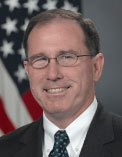Michael Vickers’s War

Very interesting piece in Friday’s Washington Post concerning a central figure in Charlie Wilson’s War. Ann Scott Tyson profiles the young ex-Green Beret officer who was the brains behind the Afghanistan Mujahedin strategy while working for Gust Arakotos at the CIA. Sorry, Charlie. This Is Michael Vickers’s War is a good read on Vickers’s next big challenge — “working to implement the U.S. military’s highest-priority plan: a global campaign against terrorism that reaches far beyond Iraq and Afghanistan”.
… Vickers, a former Green Beret and CIA operative, was the principal strategist for the biggest covert program in CIA history: the paramilitary operation that drove the Soviet army out of Afghanistan in the 1980s. The movie “Charlie Wilson’s War,” released last weekend, portrays Vickers in that role, in which he directed an insurgent force of 150,000 Afghan fighters and controlled an annual budget of more than $2 billion in current dollars.
Today, as the top Pentagon adviser on counterterrorism strategy, Vickers exudes the same assurance about defeating terrorist groups as he did as a 31-year-old CIA paramilitary officer assigned to Afghanistan, where he convinced superiors that with the right strategy and weapons, the ragtag Afghan insurgents could win. “I am just as confident or more confident we can prevail in the war on terror,” Vickers, 54, said in a recent interview, looking cerebral behind thick glasses but with an energy and build reminiscent of the high school quarterback he once was. “Not a lot of people thought we could drive the Soviets out of Afghanistan.”…
Vickers joined the Pentagon in July to oversee the 54,000-strong Special Operations Command (Socom), based in Tampa, which is growing faster than any other part of the U.S. military. Socom’s budget has doubled in recent years, to $6 billion for 2008, and the command is to add 13,000 troops to its ranks by 2011.
Senior Pentagon and military officials regard Vickers as a rarity — a skilled strategist who is both creative and pragmatic. “He tends to think like a gangster,” said Jim Thomas, a former senior defense planner who worked with Vickers. “He can understand trends then change the rules of the game so they are advantageous for your side.”
From Michael Vickers’s OSD Bio Page: Vickers was confirmed by the U.S. Senate as the Assistant Secretary of Defense (Special Operations/Low-Intensity Conflict & Interdependent Capabilities) on 23 July 2007. He is the senior civilian advisor to the Secretary and Deputy Secretary of Defense on the capabilities and operational employment of special operations forces, strategic forces, and conventional forces. He is also the senior civilian advisor on counterterrorism strategy, irregular warfare, and force transformation.
Prior to his appointment as ASD (SO/LIC&IC), Vickers served as Senior Vice President, Strategic Studies, at the Center for Strategic and Budgetary Assessments (CSBA). In this capacity, he provided advice on Iraq strategy to President Bush and his war cabinet. He also was a senior advisor to the 2006 Quadrennial Defense Review, and Executive Director of the QDR “Red Team,” which provided an assessment of the QDR for the Deputy Secretary and Vice Chairman. In late 2005, Vickers conducted an independent assessment of special operations forces (“The Downing Report“) for the Secretary of Defense. He is the author of numerous publications, among which is “The Revolution in War” (2004).
From 1973 to 1986, Vickers served as an Army Special Forces Non-Commissioned Officer, Special Forces Officer, and CIA Operations Officer. During this period, he had operational and combat experience in Central America and the Caribbean, the Middle East, and Central and South Asia. His operational experience spans covert action and espionage, unconventional warfare, counterterrorism (including hostage rescue operations), counterinsurgency, and foreign internal defense.
During the mid-1980s, Vickers was the principal strategist for the largest covert action program in the CIA’s history: the paramilitary operation that drove the Soviet army out of Afghanistan. Vickers oversaw a major change in U.S. strategy, provided strategic and operational direction to an insurgent force of more than 300 unit commanders, 150,000 full-time fighters, and 500,000 part-time fighters, coordinated the efforts of more than ten foreign governments, and controlled an annual budget in excess of $2 billion in current dollars.
—–
Links
Michael Vickers is a Busy Man – Westhawk
Charlie Wilson (Mike Vickers Bonus Edition) – Abu Muqawama




